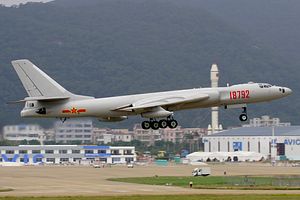How does China’s air force learn, and what are its goals as a learning organization? A recent RAND report by Scott Harold investigated this question at some length, coming to some intuitive and not-so-intuitive answers.
It is well understood that China has purchased, acquired, or adapted many aerospace technologies from other countries. This includes everything from straightforward off-the-shelf purchase of Russian aircraft, to cyberespionage directed against American producers of stealth technology. Harold suggest that the technological focus runs the risk of ignoring China’s interest in the U.S. Air Force (and other air forces) as an institutional model. Organizational structure both enables and limits the use of military force, and the People’s Liberation Army Air Force (PLAAF) has made close study of U.S. military institutions, especially in the aerospace sector. This includes command and control arrangements, training, and unit structure.
Of course, the PLAAF has substantially different responsibilities than the USAF. China has virtually no history of close air support, and its modern military problems do not, broadly speaking, involve large-scale ground combat against a capable foe. Consequently, China has borrowed very little in the way of close air support doctrine, does not have a well-developed system of negotiation and discrimination between air forces and artillery, and has never bothered to buy or steal a specialized close air support aircraft such as the A-10 or the Su-25.
Without global responsibilities, the PLAAF also need not concentrate on transport and long-range logistical capabilities to the same extent as the USAF. On this point, however, it will be very interesting to watch how the PLAAF goes about developing these capabilities, as there are essentially no useful models for emulation beyond the United States. And as China’s interest in Africa and the Middle East have grown, its need for long-range logistics have similarly increased.
The PLAAF also differs in important institutional respects from the USAF. The lack of an independent service structure makes questions of funding and mission somewhat more fluid than in the United States, meaning that the PLAAF can productively compete for the prioritization of its needs respective to the ground and naval forces. Moreover, the PLAAF does not have the primary responsibility for missile forces or for space forces. This enables it to concentrate on missions and capabilities in the air domain without needing to carve out institutional voices for space and rocket forces.
Altogether, the report suggests that China undertakes a sensible approach to emulation, one driven by the perceived military need to defeat the United States, rather than by the pursuit of prestige or a desire to mirror U.S. capabilities. As China approaches the technological frontier, its ability to learn from the United States (and others) may decrease. Similarly, while U.S. institutional models may have offered productive lessons during the growth period of the PLAAF, they may prove less useful for a mature organization carving out its own international role.
The views expressed here are his personal views and do not necessarily reflect those of the Department of Defense, the U.S. Army, the Army War College, or any other department or agency of the U.S. government.
































